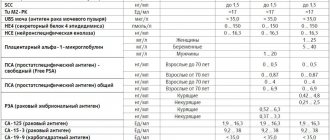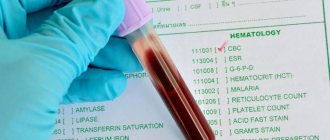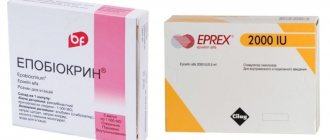The introduction of new concepts often negatively affects the psychological state of the patient when he examines the analysis form and discovers on it, in addition to his indicators, columns of numbers labeled with the term: reference values in analyses. What it is and why it is indicated next to the individual indicators handed out begins to worry the patient even more than their own results. Sometimes a person is sure that these words mean something bad and falls into complete confusion. There is no reason to worry, and this design of forms is associated with a revision of medical terminology in the light of the latest scientific distinctions. Any doctor knows what reference values and approximate indicators mean in his medical field, but they are still provided on the analysis form for his convenience.
What is the reference interval in tests?
Content
Over the course of many years of research and practice, modern medicine has discovered that the concept of “norm”, more familiar to the ear of the average patient, does not correctly reflect the essence of statistical data. The norm is a conditional term under which the indicators of an individual cannot be adjusted. Conducted research shows that for many people the concept of normal differs from the conventionally derived term norm, so this designation was considered not entirely appropriate and correct.
Reference values, norm, are terms of the same semantic series, established on the basis of an average value. The reference interval is the discrepancy in the levels of certain components observed in people who were tested for statistical data. The results of the reference interval are determined by the difference in individual indicators, external and internal conditions of the organism, and its physiological characteristics.
Should I be concerned if the test results are within normal limits?
In general, such indicators are undoubtedly a good sign and indicate the absence of any disorders in the body. However, according to many experts, a certain set of studies does not guarantee the complete absence of health problems. When statistically processing reference ranges, there is always a partial overlap between the results of people with pathologies and healthy people. In other words, in the latter, in the absence of disturbances in the functioning of the body, indicators may deviate from the norm. Likewise, in people with pathologies, test results may be within normal limits. To clarify the indicators, as a rule, repeated studies are prescribed after a certain period. When assessing the dynamics of changes, the specialist either notes the absence of violations or suspects some pathology. In the second case, additional examinations are prescribed to clarify the diagnosis.
How is it determined
To determine the reference interval, the limits of reference values are taken - the largest and smallest indicators included in the relative state of health. If the data obtained for an individual patient falls within the interval between the largest or smallest value, his body is in a state of relative health. To make sure that there is a disease in the body, if the data obtained during the analysis are not included in the reference interval, a repeat test is often prescribed. Indicators in individual studies may change in one direction or another, under the influence of various factors.
The reference interval on the analysis data is determined by conducting research on the target audience (for example, healthy middle-aged men, or people of both sexes who do not have diseases). The upper and lower thresholds are those small numbers (usually 50 people out of a thousand) with the highest and lowest scores. The remaining values will be between these limits. The reference interval takes as the norm the data obtained in 95% of cases.
Other factors that change the result
It should be noted that gender and age are not the only factors influencing the indicators. In addition, there are other reasons that may affect the result of a laboratory test.
Factors influencing reference values:
- Menstrual cycle in women. The big change concerns hormone concentrations. Their number varies according to the period of the menstrual cycle. That is why certain hormones should be detected on certain days of the cycle. The level of hemoglobin also changes; during menstruation it may be slightly below normal due to blood loss;
- Pregnancy is a physiological condition that also affects laboratory results. This applies to hormones and blood parameters (ESR, hemoglobin, leukocytes and others). The woman's body perceives the fetus as a foreign organism. This is why indicators indicating inflammation (ESR and leukocytes) increase. But for pregnant women this is the norm;
- Individual characteristics of the body. This may be a special reaction of biological material to reagents; a certain indicator is a variant of the norm only for a certain person. At the same time, no pathologies are detected in him;
- Stressful situations . Stress can cause laboratory values to change. That is why it is recommended not to be nervous before taking the test. You should calm down and relax;
- Alcohol. Alcohol negatively affects internal organs and the body as a whole. Because of this, laboratory values are outside the normal range. Before conducting a laboratory test, you should not drink alcohol for 72 hours;
- Physical exercise. Intense and regular exercise has an impact on blood counts. This is due to physiological features. The body thereby adapts to life in certain changed conditions;
- Carrying out physiotherapeutic treatment. In some cases, it can also have a similar effect;
- Nutrition. If you eat unhealthy, fatty foods the day before the test, your blood cholesterol level may be elevated. Meals should be 4 to 5 times a day. If the last meal was late, then in the morning blood glucose will be slightly elevated;
- The time at which the material was collected. That is why many tests are carried out in the morning.
Qualitative and quantitative characteristics
A qualitative characteristic is simply indicated by the words positive or negative result shown by the analysis. Quantitative characteristics are used more often, and this is information for the doctor, who, based on the obtained figures, can determine how serious deviations in the patient’s condition there are, if they are compared with what is indicated on the form as reference values. Decoding the data is usually the responsibility of a specialized specialist who knows what changes the numbers indicate. For many diseases, there are certain components of the diagnostic search, which are identified in each person using laboratory tests. If a doctor needs an exact answer in numbers, he receives quantitative characteristics on a standard form.
Don’t be shy, ask our consultants questions, right here on the website. We will definitely answer. Leave commentsGo
Why are the reference values of indicators not indicated on the website?
Most analyzes do not provide reference ranges because there are no universal reference ranges. Each laboratory, taking into account the individual characteristics of its work, indicates its own range of reference values on the analysis forms. When assessing test results, the doctor must be guided by the “standards” indicated on the form of the laboratory where the test was taken. If the study needs to be carried out several times, it is advisable to do this in the same laboratory to make it easier to compare the results.
Synonyms: reference values, reference range, reference interval, reference interval, reference range, reference values, normal range.
Established normal limits
International reference indicators are accepted only for generally accepted values - hemoglobin, cholesterol or glucose, and each laboratory sets all others based on its own data. Each laboratory may specify different ranges, and this may even depend on the measurement system in which they are reported (eg µg/liter, or µmol/l). The reference value of the analysis means nothing more than the average statistical values of studies taken from healthy patients (the norm, but recorded more correctly, according to scientists).
Why do different laboratories give different results?
Depending on the research method used and the measuring instrument, certain reference values are issued. Different laboratories may use different equipment and use one or another unit of calculation. In accordance with this, ranges of indicators are established.
When receiving the result, the form must contain the numbers and units of measurement used in a particular laboratory. Thus, in medicine there are no, for example, uniform reference values for blood tests. When reviewing the results, the specialist should refer to the numbers used by the institution where the patient was examined. The difference can be seen by considering, for example, some reference values of a biochemical blood test. Thus, the range of indicators for ethylidene when studied by the G7PNP method is 28-100 U/l, and by the CNPG3 method - 22-80 U/l.
Range of reference values in different laboratories
Each laboratory conducting diagnostics is guided by its own results obtained during research, and only where generally accepted medical standards exist does it refer to them. This is where the difference appears, which frightens patients who have undergone tests at different diagnostic institutions.
A doctor studying test results is not always guided by the reference data of a particular laboratory. Practical knowledge may prompt him that the upper or lower limit in the resulting analysis may differ in a particular area (due to unfavorable ecology or climatic conditions). He has the right to rely on data in the medical literature, or prescribe diagnostics in another laboratory. It is likely that an indicator that poses some threat to the patient's condition will be included in the reference interval in an institution using other numbers or calculation systems.
Reference values - what are they? What does “reference value” mean?
When carrying out any diagnostic measures, the research results are considered comprehensively. In this case, all indicators are taken into account: the general condition of the patient, the nature of the pathology, symptoms.
Quantitative and qualitative research
The results of a number of laboratory tests are given to patients as “positive” or “negative”. This form is considered a quality characteristic. An example would be an analysis for antibodies to a particular infection. A positive result indicates the presence of these antibodies in the material.
What does “reference value” mean?
In the quantitative type of research, the results are given in the form of numbers. At the same time, there is a range of norms, as well as averages. The reference value in analyzes is a medical term used to evaluate the results of laboratory tests. It is defined as the average value of a certain indicator. These data were obtained by examining a healthy part of the population. To begin with, we can look at some reference values for thyroid hormones. For example, for free T3 the normal values will be 1.2-2.8 mIU/l, and for thyroxine (total) – 60.0-160.0 nmol/l. This is what a TSH analysis indicator may look like: reference values are 0.5-5.0 µIU/ml, and the result itself is 2.0. As can be seen from the last example, the figure obtained from the study is within the normal range.
How are normal boundaries determined?
The only way, as mentioned above, is to examine healthy people. The first step is population sampling. For example, healthy women aged from twenty to thirty years are invited. Most of them are assigned to clinical trials. The results are reduced to average figures, calculating the range in which the reference values are located. A deviation from normal indicators (in one direction or another) is allowed by two standard units.
Why do different laboratories give different results?
Depending on the research method used and the measuring instrument, certain reference values are issued. Different laboratories may use different equipment and use one or another unit of calculation. In accordance with this, ranges of indicators are established.
When receiving the result, the form must contain the numbers and units of measurement used in a particular laboratory. Thus, in medicine there are no, for example, uniform reference values for blood tests. When reviewing the results, the specialist should refer to the numbers used by the institution where the patient was examined. The difference can be seen by considering, for example, some reference values of a biochemical blood test. Thus, the range of indicators for ethylidene when studied by the G7PNP method is 28-100 U/l, and by the CNPG3 method – 22-80 U/l.
Why might indicators be outside the norm?
The reference value in analyzes is statistical data, but not a biological law. In some cases, deviations from the established ranges may occur even in healthy people. What could be causing this? Among the many causes of deviations, the physiological characteristics of the body are of particular importance. If a specialist recommends undergoing one laboratory test several times, then there is a certain probability that the results will show a deviation from normal limits. Due to biological reasons, indicators may vary daily. To compare the results, the doctor prescribes tests again. As a rule, diagnostic conclusions are made not in accordance with single indicators, but by assessing the dynamics of changes. In healthy people, data may not fall within generally accepted ranges.
At the same time, for the people themselves, the results will be considered the norm. Such cases usually involve minor deviations. However, indicators that do not fall within the reference values may indicate disorders in the body that require further diagnostic measures. When assessing the research results, the specialist takes into account the patient’s general condition, clinical picture, studies the medical history and other factors. As a result, the doctor determines what the deviation from normal numbers indicates.
What factors may influence research results?
The laboratory can provide results to the patient according to his gender and age. For example, reference values of creatinine (when examining serum) in men under 50 years of age are 74-110 µmol/l, after 50 – 70-127 µmol/l. In women, the indicators are established regardless of age and are 60-100 µmol/l. Reference hCG values for the fair sex depend on whether the patient is pregnant or not. The results of the studies may be affected by the treatment received, features of the daily routine and diet. Bad habits are also an important factor: smoking, alcohol or coffee abuse. Even the patient’s posture during the delivery process can affect the performance. For example, calcium and albumin levels may increase when the patient's position changes from horizontal to vertical. To obtain a more accurate result, before the study, a specialist may recommend eliminating physical activity, stressful situations, quitting smoking and alcohol, and taking medications and vitamins.
The influence of physical activity on results
It is not recommended to visit the gym on the eve of the study. Physical activity affects the enzymatic activity of creatine phosphokenase, lactate dehydrogenase, and aspartate aminotransferase. Athletes who have been involved in weightlifting or athletics for many years may have elevated levels of luteinizing hormone, platelets, and testosterone. Considering all these factors, certain rules should be followed before taking tests. When preparing for certain tests, the doctor, as a rule, gives special recommendations. If the patient follows the specialist's instructions, then he has a much greater chance of getting accurate and correct results.
Common Misconceptions
There are several misconceptions about reference values and, in fact, research results. Many people believe that deviations from the norm certainly indicate disorders in the body. However, this is not always the case. Results outside the generally accepted ranges indicate the need for further testing or repeat testing. It is likely that the result does not indicate a violation, but falls into 5% of cases in which deviations are observed in healthy people. In any case, the doctor will take the necessary measures to accurately assess the situation. As mentioned above, there are many factors that can influence the result. For example, increased blood sugar may not indicate diabetes, but errors in nutrition. Lipid levels increase if the test is not taken on an empty stomach. An increase in liver enzymes may be associated with alcohol consumption on the eve of the study, and not with cirrhosis. Among other things, the medications taken also affect the results. Today, pharmaceutical companies produce a huge number of drugs. Laboratories sometimes simply do not have time to assess their impact on blood parameters or other test material. In some cases, values can return to normal on their own if they were on the border of reference values.
Is it possible to work in catering with hepatitis B?
Should I be concerned if the test results are within normal limits?
In general, such indicators are undoubtedly a good sign and indicate the absence of any disorders in the body. However, according to many experts, a certain set of studies does not guarantee the complete absence of health problems. When statistically processing reference ranges, there is always a partial overlap between the results of people with pathologies and healthy people. In other words, in the latter, in the absence of disturbances in the functioning of the body, indicators may deviate from the norm. Likewise, in people with pathologies, test results may be within normal limits. To clarify the indicators, as a rule, repeated studies are prescribed after a certain period. When assessing the dynamics of changes, the specialist either notes the absence of violations or suspects some pathology. In the second case, additional examinations are prescribed to clarify the diagnosis.
fb.ru>
What does a result outside the reference values mean?
Unlike the norm indicators established by international standards, an indicator that goes beyond the boundaries in one direction or another is not a sentence or even a diagnosis. It's just a certain result. Reference values are obtained on the basis of statistical data, but are not a biological law or a mandatory limit for a healthy person. To correctly navigate inflated or underestimated figures, it is recommended:
- carry out repeated diagnostics in another laboratory;
- exclude possible factors that distort the clinical picture;
- do the analysis again in the same laboratory, after some time, and consider the average of all analyzes as the result obtained.
If diagnostics showed an increased content of a particular element, this may be explained by objective reasons, or errors in the equipment and methods used. A reference value of 0 simply means that the laboratory does not have relevant statistics.
Norm
International standards do not provide references for all parameters. So, this includes cholesterol, sugar, antigens.
For many other indicators of human fluids, laboratories already indicate their reference interval. This is why we get different data in every laboratory. The main thing is to look at the reference. If they fit there, then everything is in order.
Results in laboratories vary due to the fact that each of them has its own equipment and methods of studying the material. All scientific research centers (research centers) may have their own number systems.
For example, when determining the norm of folic acid, the limits are from 400 to 1600 mcg/l. If you choose another system, then the values there look completely different - from 7 to 28 µmol/l.
Private laboratories usually indicate on the form which unit of measurement is chosen.
As can be understood from the above information, the reference interval is a kind of statistics, not a law. That's why you can't rely on them completely. Often, during the study, data is provided that the concentration of a certain indicator is exceeded. And this does not necessarily indicate a disease. Perhaps this is an individual state of the body. Or the result was influenced by some factors.
What do reference values mean in analyzes if the result is always outside their boundaries? This happens often. The patient donates blood regularly and the doctor sees that the indicators are not within the norm. And then the doctor calculates the average of all received values in order to be guided by it. And yet, if a person has elevated levels of certain substances in the blood, one needs to look for a source of inflammation or infection. Chronic pathology can also behave this way.
To obtain the correct result, you should follow your doctor's recommendations before taking the tests. In addition to age characteristics and belonging to one gender or another, there are other reasons. Here they are:
- bearing a child;
- days of menstrual bleeding;
- abuse of alcoholic beverages;
- nervous tension;
- poor nutrition;
- physiological characteristics of the body;
- taking medications;
- time period of the day;
- excessive physical loads;
- conducting physiotherapy.
Factors influencing the reference value
The reference value is influenced by endogenous and exogenous factors of negative significance (diseases, inflammations, infections, colds, etc.). But it is no less susceptible to the simple conditions of everyday existence. In women, these are hormonal disorders (menstruation, pregnancy, ovulation, menopause). Common to all may be:
- psycho-emotional disorders and stress;
- overwork and physical exertion;
- improper or untimely nutrition;
- physiotherapy;
- taking alcohol or medications;
- time of day at which the analysis was carried out.
We should not forget about the individual characteristics of each organism. They may involve going beyond the statistical indicator, but indicate the healthy state of a certain person.
What physiological factors influence the result?
Laboratory test results are influenced by various factors. They can be internal or external (endogenous and exogenous). The main physiological factors influencing the reference interval include a person’s age and gender.
Analysis data based on age are divided not only into 2 groups: children and adults. In children, the result depends on what age group the child belongs to. This is due to the fact that children grow and develop and, in connection with this, physiological changes occur in their bodies. Quantitative indicators when studying biological material also change.
In adults, the main indicators do not depend on age, or minor fluctuations in the individual are observed within the reference values.
Gender has a significant impact on test data in adults and adolescents over 14–15 years of age. In children before puberty, there are no differences in test results between boys and girls. In adults, gender affects indicators, which is due to the peculiarities of biological processes.
Significant differences in men and women are detected when testing blood for biochemistry and hormones:
- Creatinine is a breakdown product during the creatine-phosphorus reaction. This product is formed in the muscles. That is why it is logical that this figure is higher for men, because their muscle mass is greater than that of women;
- Sex hormones are not the same among representatives of different sexes. In women, the concentration of these hormones depends on the phase of the menstrual cycle. In men, the amount of testosterone should be stable.
Reference range norms in children
The reference range in childhood is established based on the age indicator. The characteristics of the child’s body and the intensity of its development imply certain numbers for each age indicator. Not only are they different from adults, but they are also different at each stage of growth. For example, the hemoglobin indicator on the first day is 179-241, in the first month of life it should be 114-176, and from one year to 6 the reference value is 110-139. Children also have distorting factors and individual characteristics in which the result may be out of bounds.
Children
Many parents wonder what are reference values in urine and blood tests in children? Does it differ from adult indicators? Collection of material for analysis can be carried out even from a newborn patient. This helps neonatologists begin treatment immediately if necessary.
The indicators immediately after birth and some time after it are not similar to those to which we are accustomed. A blood test can be alarming with too high levels of hemoglobin, red blood cells and other blood parameters. But it normal. Over time they gradually decrease.
For children in the first day of life, the values of the main blood parameters look like this:
- Red blood cells - 4-8;
- Hemoglobin 179-241;
- Platelets - 180-500
- Leukocytes 9-25;
- Reticulocytes 30-51;
- Lymphocytes 13-37.
And now, closer to 12 months, the reference values change significantly:
- Red blood cells - 4-5;
- Hemoglobin 110-137;
- Platelets - 180-390;
- Leukocytes 6-12;
- Reticulocytes 3-15;
- Lymphocytes 39-73.
Reference interval in tests in adults
In tests issued to adults, the age category and gender of the patient being studied must be taken into account. You should not immediately look for standards that should be present in indicators of relative health. Only the attending physician who is familiar with all the components can decipher the analysis. He may advise changing the laboratory or eliminating possible objective distorting factors, monitoring compliance with the necessary conditions, and taking into account the individual characteristics of his patient.
The influence of physical activity on results
It is not recommended to visit the gym on the eve of the study. Physical activity affects the enzymatic activity of creatine phosphokenase, lactate dehydrogenase, and aspartate aminotransferase. Athletes who have been involved in weightlifting or athletics for many years may have elevated levels of luteinizing hormone, platelets, and testosterone. Considering all these factors, certain rules should be followed before taking tests. When preparing for certain tests, the doctor, as a rule, gives special recommendations. If the patient follows the specialist's instructions, then he has a much greater chance of getting accurate and correct results.
Normal for pregnant women
The norm for pregnant women is established depending on the period and is determined according to a special table (if we are talking about human chorionic gonadotropin. But the discrepancy between the norm numbers is quite significant, so the doctor is responsible for deciphering the analysis indicators. There is no need to draw any hasty conclusions until repeated studies are carried out.
What is the reference range?
The reference range or reference values (from the English reference range, reference interval; or reference values) are established during clinical studies, during which a large number of healthy people are tested, grouped by gender, age, ethnicity and other factors. The obtained data are analyzed, brought to the average value and, through mathematical and statistical approaches, a reference interval is established, which includes the data of 95% of healthy people. That is, in 5% of cases in healthy people, the test results fall outside the reference range.
It is preferable to use the term “reference range (interval)” rather than “normal range” because “reference” implies that the data can be applied to a specific group of people. When considering the results of the analysis of different groups of people, it becomes clear that what is “normal” for one group will not necessarily be normal for another. For example, during pregnancy there are changes in the body, as a result of which pregnant women have their own “normal values” for many tests, which are very different from the values of non-pregnant women of the same age.
Reference values may differ between laboratories, as laboratories use different types of equipment and different research methods. Therefore, each laboratory sets its own reference values.
Reference values in blood tests
A blood test is not only biochemical indicators. It is often prescribed to determine other data about the presence or absence of certain components. Each type of blood test has its own established data, combined into special tables. We should not forget about the difference in distortion due to objective reasons, the difference determined by age and gender.
Tumor markers: reference values
Decoding the analysis for tumor markers is the exclusive prerogative of the oncologist. The final diagnosis may depend on each specific species, its quantity and the fact of its presence. But only the fact of their existence. if they are in smaller quantities than the reference value dictates, it means nothing. Tumor markers can normally be present in a healthy person. It's not about the fact of presence, but about its combination with other indicators.
Reference glucose values for diabetes mellitus
If all the necessary conditions for taking the test are met (blood from a vein and strictly on an empty stomach), there are certain standards that should be reflected in the analysis:
- in adults - 4.1–5.9 mmol/l;
- in infants up to 1 month. - 2.8–4.4 mmol/l.
- in children from one month to 14 years - 3.3–5.6 mmol/l;
- in older people (from 60 years of age) and pregnant women, levels can reach 4.6–6.7 mmol/l.
Discrepancies by insignificant numbers do not mean the presence of diabetes mellitus. Its presence is established after several laboratory tests carried out repeatedly. Insulin also plays an important role in this process, the reference values of which are also important when making a diagnosis.
Hormone reference values
The human body produces a significant amount of hormones produced by the organs of the endocrine system. Each of them has its own approximate reference values, determined by the corresponding hormone tests. The concept of relative normal may vary depending on gender, age and physiological state being studied.
Reference TSH values
Analysis for thyroid-stimulating hormone plays an important role in the diagnosis of negative conditions caused by TSH deficiency in the body. The peculiarity of determining the reference values of thyrotropin consists in age, gender and the available indications for its measurement (external and internal signs indicating its deficiency or excess). Only an endocrinologist should decide on the need for therapy and establish a specific diagnosis, based on all the necessary diagnostic indicators.
Analysis decoding. Normal or pathological?
When establishing a reference range, mathematical and statistical approaches are used, according to which the values of the results of laboratory tests of a certain analyte of 95% of healthy people fall within the established interval. Accordingly, for 5%, the values of the analyzed indicators are outside the established range. In other words, in 5% of cases, “abnormal” laboratory parameters are detected in healthy people, which should be taken into account when interpreting the analysis. This is explained by a number of reasons.
Firstly, the division of the biological population of people into “sick” and “healthy” according to many laboratory indicators is very conditional. Being statistical data, the limits of normal laboratory values may vary. Therefore, it happens that in healthy people, certain indicators that are the “norm” for them are not ultimately the “norm” for the majority of others, and therefore do not fall within the range of generally accepted reference values. In this case, the limits of the reference range cannot serve as absolute indicators of health or disease.
On the other hand, the disease often develops unnoticed, manifesting itself as a gradual transition from small deviations in laboratory parameters to higher values as dysfunction and severity of the disease increases. In this regard, when deciphering tests and interpreting the results of laboratory tests, it becomes very important for the clinician to assess the dynamics of changes in a specific laboratory indicator in a specific patient. In doubtful cases, the main criterion for the presence or absence of the disease is clinical symptoms or the degree of its severity. If there are symptoms of the disease, additional laboratory tests are used for diagnosis using highly sensitive and specific tests that most significantly change their values against the background of the suspected disease.
Secondly, “healthy” and “sick” people actually belong to two different populations, and when these populations are mixed with each other, it is almost impossible to recognize each of them in the total mass. In addition, in different patients, the same indicator can not only take on different values, but also overlap the values of this indicator in healthy people. Moreover, for different indicators, different diseases, different groups of patients, the magnitude of this “crossover” can vary greatly: from too small, which can be neglected, to very significant, when a special approach and careful analysis of all data is required to classify the result as “normal” or "pathological". The latter is extremely important to take into account when assessing the results of laboratory tests, since in this case not all values outside the normal range will indicate the presence of pathology. The range of values in which the laboratory parameters of “sick” and “healthy” individuals overlap is called the zone of uncertainty, or the “gray zone”. It exists for a number of laboratory techniques, but is most often found in the results of enzyme immunoassays. If a result falls into the “gray zone,” it cannot be unambiguously regarded as either normal or pathological and is considered doubtful. In such a case, the patient is usually recommended to repeat the diagnostic test 2 to 4 weeks after receiving an indeterminate result.
And finally, an indicator lying in the reference interval cannot always be considered normal, since the range of many of them is quite wide. For example, the normal hematocrit (Ht) value in men varies from 42 to 52%. Massive blood loss can lead to a drop in this indicator from 52 to 42%, while the value of 42% remains within the range of reference values, and therefore may not cause alarm to doctors. However, in a certain situation, for a particular patient, such a decrease in hematocrit can not only be clinically significant, but also be critical.
Thus, results within the reference range are not always the norm. And, on the contrary, results that go beyond the reference values are not always a pathology, but only a significant prognostic sign that can signal a possible pathological process. In this regard, in laboratory diagnostics an approach is becoming increasingly widespread when the most significant and adequate reference values for each individual patient should be considered the stable results of his laboratory tests obtained over several years. Even now, experts all over the world are inclined to believe in the need to “lower” the importance of reference intervals, moving away from treating them as some kind of “absolute” criterion for assessing a laboratory result. This circumstance in no way reduces the importance of laboratory research. They remain the most important tool for diagnosing pathological conditions, monitoring the course of diseases, identifying the preclinical stage of diseases during screening examinations, and also largely determine the further tactics of diagnostic procedures and making treatment decisions. However, this approach directs the clinician to a more cautious use of reference values in assessing “normal” and “pathological” results, indicating the need for their interpretation taking into account possible biological variation in the population, taking into account data from the clinical picture and other types of studies in the aggregate, and also those factors that may influence the results of laboratory tests.
Reference values in stool
Stool tests are prescribed for many pathologies of the digestive system or suspicions of parasitic infestations, so the reference value may concern consistency, color, content of parasites, larvae or eggs, the presence of mucus or blood, and other reactions - all this is information that the doctor will decipher.
By the way, read more on this topic: Stool analysis for scatology
Obtaining data from laboratory tests is a way to get an idea of the nature of the pathology or to ensure its absence. A person’s concern about his own health is quite understandable, and when he asks: reference values in analyzes - what are they - is quite understandable. But reference values are not a dogma or a biological law, but just statistical data obtained by a certain laboratory when examining healthy people.
When are reference values not relevant?
The reference interval is important for identifying various diseases and assessing the general condition of the human body. However, there are situations in which the boundaries of the norm are not taken into account. In this case, the doctor evaluates the previous and current value of the indicator. They are compared to see in which direction the indicator has changed.
Most often, reference values are not paid attention to in the following cases:
- Treatment of drug addicts;
- Treatment of cardiac patients with high cholesterol;
- Terminal stage of diabetes mellitus.
In all of the above cases, the doctor makes sure that the indicator he is interested in decreases. Then this will indicate the effectiveness of the therapy.
If narcotic substances and their breakdown products are found in the blood of a drug addict during treatment, this indicates non-compliance with the regime. This means that the person continues to use prohibited drugs.
Quite often, the reference interval is not considered if the patient has severe pathology and maintenance therapy is carried out. In this situation, doctors monitor that the indicators do not decrease or increase even more.
General blood test in adults: normal indicators and interpretation of results
Often a visit to the doctor ends with the doctor giving you a referral for a complete blood count (CBC). This study confirms or refutes the primary diagnosis, allows you to monitor the course of the disease, and is also often carried out for preventive purposes to make sure that a person does not have any hidden pathologies.
Despite the fact that a general blood test includes only a few parameters, deciphering its results is problematic without the participation of a doctor. But some conclusions can still be drawn independently, based on the normal values of the UAC, which we will discuss in more detail in this article.
Influence of a person's gender
The reference value depends not only on age. The gender of the person being examined has a great influence on the indicators. For example, the creatinine level is used to check the proper functioning of the kidneys. It is formed as a result of metabolism in the muscles and, after being released into the blood, is excreted through the kidneys. As you know, men's muscle mass significantly exceeds women's. Therefore, the reference range for women is significantly lower than for men. The same situation occurs with CK-MB, a form of the enzyme creatine kinase. An increase in its level indicates damage to the heart muscle. A study of the concentration of this enzyme makes it possible to diagnose angina pectoris. Due to their higher muscle mass, men have higher CPK levels than women. There are situations when the reference value depends on both gender and age at the same time. An example would be menstruation in women, during which hemoglobin and hematocrit levels decrease due to blood loss.
Norm and reference interval
The reference value is the norm, which is designated within the range of acceptable indicators. Previously in medicine, such a term as “reference value” did not exist, since everyone was talking about the norm. However, the concept of “norm” has too narrow a meaning. Eg:
- whether there are antibodies to the virus in the blood;
- a lot or a little troponin in the blood.
Sometimes values cannot be accurately defined due to various factors, which is why it was decided to expand the range, which is now called the concept of “reference interval”.
Thanks to the reference interval, it is possible to identify the average value of the clinical indicator, which is obtained during numerous examinations of healthy patients. The test results are deciphered in conjunction with various indications and characteristics of the patient.
Some laboratory tests may give the patient a clear “yes” or “no” answer. This type of diagnosis is called qualitative analysis, which is often found when antibodies to a specific virus are detected. If the result is positive, they indicate the presence of such antibodies in the blood. But there are also reference values that are given in a range, that is, in the reference interval. For example, when analyzing the level of thyrotropin, the following is revealed:
- 2.0 µIU/ml – average normal value;
- reference interval – 0.5-5.0 µIU/ml.
That is, the final result will be normal if it falls in the range between 0.5-5.0.
Common Misconceptions
There are several misconceptions about reference values and, in fact, research results. Many people believe that deviations from the norm certainly indicate disorders in the body. However, this is not always the case. Results outside the generally accepted ranges indicate the need for further testing or repeat testing. It is likely that the result does not indicate a violation, but falls into 5% of cases in which deviations are observed in healthy people. In any case, the doctor will take the necessary measures to accurately assess the situation. As mentioned above, there are many factors that can influence the result. For example, increased blood sugar may not indicate diabetes, but errors in nutrition. Lipid levels increase if the test is not taken on an empty stomach. An increase in liver enzymes may be associated with alcohol consumption on the eve of the study, and not with cirrhosis. Among other things, the medications taken also affect the results. Today, pharmaceutical companies produce a huge number of drugs. Laboratories sometimes simply do not have time to assess their impact on blood parameters or other test material. In some cases, values can return to normal on their own if they were on the border of reference values.
Influence of age on the range of parameters
Very often there is no identical reference value for everyone. The results of the studied parameters may be influenced by the patient's age. For example, this concerns the level of the enzyme alkaline phosphatase. Its concentration is not the same at different ages. The level increases depending on the rate of creation of new bone cells. Therefore, increased levels of alkaline phosphatase are observed in childhood and adolescence. It is essential for the growth and development of healthy bones. High indicators in this case are taken as the norm. In an adult, an elevated level of alkaline phosphatase indicates the presence of various diseases. For example, these include osteoporosis, the development of metastases in bone tissue, and others. Also, with age, the level of hemoglobin and hematocrit decreases. Therefore, taking into account the age category, different indicator limits have been established.
Terminology
First of all, you need to understand what the definition itself is. “Reference values” is a special term in medicine that denotes the boundaries of the norm. There are two options for laboratory test results. The first, qualitative, determines the presence or absence of antibodies, positive or negative, for example, culture for bacteria, etc. In this case, no reference values were found. The second research option is quantitative. It shows the result in digital value. As a rule, the description indicates the identified indicator and its reference value. Looking at the numbers, it is quite easy to determine whether the result is within the normal range or not. It should, however, be said that for the same studies, the boundaries (range) of indicators may be different depending on the individual characteristics of the patient, age, gender, for example.
Reasons for increasing the number of leukocytes
The reason why they decided to change the first name to the second was the following. In order to obtain the optimal value, scientists conducted many studies, collecting a whole group of people, which was formed according to special physiological characteristics (age, gender, and so on).
That is why the concept of normal, so familiar to any patient, as well as to the doctor, was changed to referral, that is, where both lower and upper limits are clearly marked.
There is no need to be alarmed if you see the term reference in your card or transcript of the analysis. This word is just a term, a synonym of which can be considered the norm.
This group of indicators is important when assessing anemia conditions. They can also be used to assess the functions of red blood cells and hemoglobin. Let's look at each one separately.
Red blood cells (RBC)
They are the most numerous blood cells. They are a curved disc that is yellowish in color. But then, when the small red blood cells gather into a larger pool of cells, their hue turns red. It is due to the hemoglobin content in them. The main function of the red blood cell is to transport dissolved oxygen to cells and tissues.
Hemoglobin (Hb)
Each hemoglobin molecule contains iron in a different state. Thanks to it, oxygen is bound, which is then given to the cells. In addition to participating in the transport of oxygen, hemoglobin also interacts with carbon dioxide. That is, through this protein, oxygen is delivered and carbon dioxide is removed.
The number of red blood cells, hemoglobin, hematocrit and other indicators depend on the age and gender of the person. Each laboratory has its own reference values, which is related to the type and modernity of the equipment used.
- In men, the hemoglobin level is below 135 g/l and the hematocrit is below 40%.
- Among women, hemoglobin is less than 115 g/l, and hematocrit is below 35%.
https://www.youtube.com/watch?v=51n7O7Jpce8
In children, anemia can be suspected when hemoglobin decreases to less than 110 hl. It is also worth remembering the reference levels for each age, which were given above in the tables.
- pale skin;
- increased fatigue, drowsiness;
- dyspnea;
- dizziness, headaches.
The causes of anemia may be associated with acute blood loss, impaired blood formation, and an increased rate of destruction of red blood cells. The erythrocyte index, as well as other laboratory tests, helps in accurately identifying the causes.
- Microcytic. This often includes iron deficiency and thalassemia. As the name suggests, this condition occurs due to iron deficiency.
- Normocytic. This group is quite extensive. Usually these are anemias that are associated with the presence of some chronic disease. These include blood loss due to hemorrhoids. This group also includes increased cell destruction and damage to the red bone marrow.
- Macrocytic. This type of anemia develops due to the formation of abnormal large red blood cells. This often happens with a deficiency of B12 or folic acid.
Using a general blood test, you can try to determine the cause of anemia. In some cases, anemia is a symptom of another serious disease.
Reasons for the increase
- bone marrow tumor;
- diseases of the lungs, kidneys, excessive physical activity;
- obesity and high altitude;
- various kidney tumors;
- dehydration, smoking, stress.
The reasons for the increase can be pathological and physiological. In most cases, the number of red blood cells increases relatively, that is, due to a decrease in other blood cells.
Physiological changes in red blood cell count
The next group of indicators that are determined in a general clinical blood test. These cells are also called white blood cells. Leukocytes are classified into: neutrophils, eosinophils, basophils, monocytes and lymphocytes. The total number means the totality of all listed cells.
The number of leukocytes in the blood is one of the important diagnostic signs. Their increase occurs with pronounced protection of the body from the influence of foreign agents. Therefore, when receiving the results of a general blood test, the number of leukocytes should be assessed.
The picture shows the normal number of leukocytes and the leukocyte formula. The division is based on age.
White blood cell count is normal
It should be noted that this number of leukocytes reflects the totality of all cells. That is, their increase can also occur due to monocytes or basophils.
If there is an increase in leukocytes in the general blood test, you should immediately consult a doctor.
Neutrophils
The largest portion of cells of all leukocytes. They are the first link of immunity when pathogenic bacteria enter the body. Therefore, their number increases markedly during an acute inflammatory reaction. Normally, the blood contains segmented cells and a small number of band cells.
An increase in neutrophils in the blood is called neutrophilia. When this increase occurs over 8*10^9. And the decrease is called neutropinenium (1.5 * 10^9).
Table of normal neutrophil levels
| Age characteristics | Allowable range | Percentage |
| 1 year | 1,2-8,2 | 30 |
| 5 years | 1,3-8,6 | 55 |
| 11 years | 1,2-7,9 | 60 |
| 22 | 1,1-7,9 | 70 |
| More | 1,3-7,9 | 70 |
The number of neutrophils is a kind of indicator of the condition of the body. Such cells are second in protection, after the skin.
Description of neutrophils
Cells that are much larger than neutrophils. Take part in the destruction of foreign material. Eosinophils actively migrate to foci of allergic inflammation. They are also able to neutralize parasites and then phagocytose decay products.
The picture shows the maximum levels of eosinophils depending on the age of the patient. And also their level in percentage terms.
Reference levels of eosinophils
Basophils take part in allergic reactions. Therefore, their number increases in bronchial asthma, in people with increased sensitivity to flowering, etc. In adults, the number of basophils should not exceed 0-0.02%.
https://www.youtube.com/watch?v=1MdXl68pCEs
Monocytes are immune cells. Their main function is to absorb bacteria, viruses, and parasites. Normal values are 0-0.08%.
Lymphocytes, like other cells of the white germ, take part in the immune response. Their main function is to recognize foreign agents. The normal lymphocyte count is 1.0-4.5. The percentage is 34.
Functions of leukocytes in the human body
The main function of leukocytes is to protect the body from foreign agents. These include bacteria, viruses, fungi, and protozoa. They also help limit and eliminate the inflammatory response, tissue and cell damage. For this reason, an increase in the number of leukocytes occurs with the development of pathological conditions in the body.
- Acute bacterial infections. These include localized forms (angina, abscesses, appendicitis, otitis, salpingitis, meningitis, acute cholecystitis) and generalized (sepsis, pleural empyema, peritonitis).
- Exogenous and endogenous intoxication. These include bites of various animals and insects, taking medications, vaccines, uremia, and diabetic acidosis.
- Acute bleeding and myeloproliferative diseases.
An increase in the number of neutrophils indicates the presence of a purulent inflammatory process. Therefore, this parameter is considered important in diagnostic terms.
Functions of neutrophils
Let's look at the reasons why the number of eosinophils increases. In another way, these cells can be called markers of an allergic reaction. If the increase in neutrophils is more of a bacterial nature, then the increase in eosinophils is more allergic.
- Allergic diseases. These include bronchial asthma, allergic dermatitis, hay fever, allergies to medications, food products, and plant blooms.
- The appearance of parasitic infestations in humans. For example, an increase in eosinophils can occur in the presence of ascariasis, giardiasis, opisthorchiasis.
- During the formation of tumors. Eosinophils increase in hemoblastoses.
- Severe immunodeficiencies and connective tissue diseases.
It is worth noting that in allergic conditions, the number of eosinophils can increase to 1.5 * 10^9.
- Allergic reactions that occur when ingesting food, medications, or vaccines.
- Lymphogranulomatosis.
- Chronic ulcerative colitis.
- Thyroid gland dysfunction.
- When taking estrogens.
Basophils and monocytes increase extremely rarely. However, a relative increase in the number of monocytes occurs with vasculitis, endocarditis, and sluggish sepsis. This is also observed in people recovering from severe infections.










